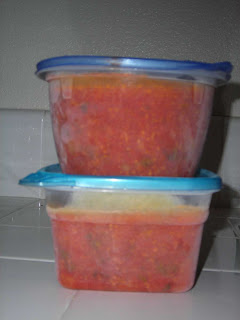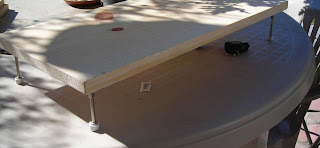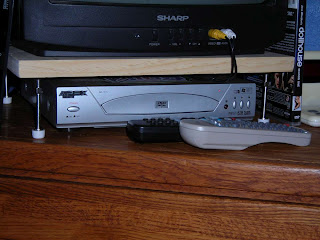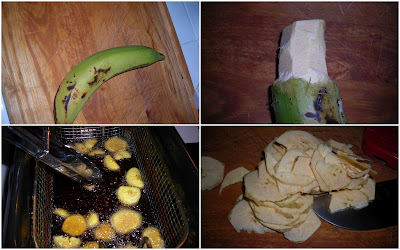
This year was a good year for cherry tomatoes in the garden. Unfortunately, not much of the other tomatoes grew, so I had a plethora of cherry tomatoes and not much else. Ugh! Anyway, I could only give away and eat so many, so naturally I began thinking of ways to preserve the tomatoes so we can enjoy the goodness during the off season. I decided to give a crockpot tomato sauce recipe a try. (Well, I didn't really follow a recipe but I think it turned out okay). Don't forget to rinse your tomatoes.
With most tomato sauce recipes, they tell you to go thru the process of seeding and skinning the tomatoes. No way, was I about to do that to a million cherry tomatoes. So, I pretty much figured, the seeds don't really bother me, especially with cherry tomatoes because they're usually so small and the skin so thin... So, I just threw it all in the blender and bzzzzz. If you want to limit some of the skin and seeds you can definitely put it a couple of layers of cheese cloth. It may take a while to drain.

Once it's all blended up, pour the whole thing into the crockpot, add in whatever ingredients you want to use within your tomato sauce. I sauted some garlic and onions, and threw it in. In previous sauces I've added in other fresh herbs like basil, parsley, oregano, chives, and a some thyme along with the onion and garlic and even a couple of tablespoons of sugar.
Turn on the crockpot onto low and let it go for 5 to 6 hours. I also stirred occasionally to make sure nothing was sticking in the bottom, and to check the thickness. Once those 5 to 6 hours are up or the sauce gets to as thick as you want it you can now choose how you want to store it. (if you like your sauce to be somewhat thicker like marinara, you can optionally put in a small can of tomato paste -- I read somewhere that you loose some flavor the longer you cook tomatoes. Never noticed it, but thought I'd mention it.
In storing the sauce, you have two good options. One is to freeze it. Place the sauce in a freezer suitable container and put it in the freezer. Give enough room to account for expanding liquid. The second option is to can the sauce. I forgot to take pictures thru the process of canning, but we used a pressure cooker canner. Put a tsp of lemon juice in each jar before you put the sauce in. Next, place 2 inches of water in the canner, and bring to a boil, Then place the jars in (on a rack) the canner and close up. I believe we processed the cans for 25 minutes taking an average of all the times we saw online. Don't forget that the processing begins when the cooker is pressurized (or the weight on top begins to rock). Once the 25 minutes are done, just turn off the stove and walk away. You want the cooker to release the pressure slowly as it goes back to room temperature. I left it alone and opened it up the next morning, but I was also doing the canning close to 11 at night.

And there you have it... Crockpot tomato sauce for your use throughout the rest of the year. We use it for several things such as pasta sauce, pizza sauce, and marinara sauce. Usually, we will add some tomato paste to it at this point, which is why I didn't bother putting it in during the crockpot cooking.

![]()
[Update 10/13/2009: I just found
another recipe for slow cooker tomato sauce. ]

















